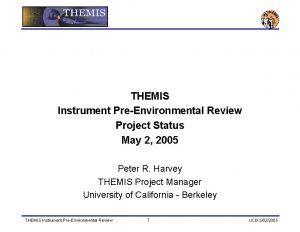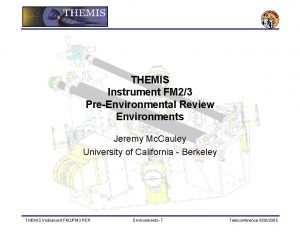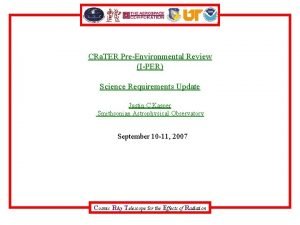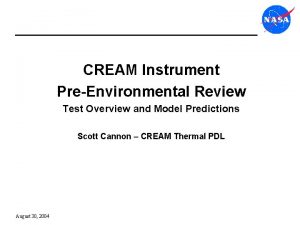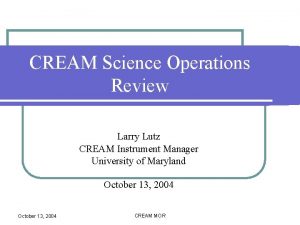CREAM Instrument PreEnvironmental Review Thermal Vacuum Review of




- Slides: 4

CREAM Instrument Pre-Environmental Review Thermal Vacuum Review of Aug. 24, 2004 Recap Mark Cascia August 30, 2004

Thermal Vacuum Review Recap • Meeting held August 24, 2004 • Purpose: – In response to an Action Item given to Project during Program Management Council (PMC) to review the change of the Instrument Thermal Vacuum Test from 3 cycles to 1 cycle • Background: – CREAM Mission de-scoped from 100 -day ULDB mission to single circum-polar LDB mission of approximately 10 -15 days. – CREAM Instrument is SRT funded instrument • PI is wholly responsible • NASA's role: – assist PI with providing TVAC services – provide thermal analysis for the instrument – SRT instruments have 14 year successful track record – NASA has, in past, only required that SRT instruments undergo thermal analysis and test flight, while encouraging substantiation via TVAC. – Sufficient de-coupling exists between instrument and Ballooncraft Support Systems (CDM) such that neither is at risk from the other. – Instrument TVAC not needed to provide assurance that it's thermal performance and configuration has no detrimental effect upon other flight support systems. August 30, 2004

Thermal Vacuum Review Findings • Findings: – Five days of testing can provide at most 1 cycle due to large thermal mass and radiative coupling only to chamber. Although a 3 cycle thermal test as originally planned may reveal some workmanship related issues and is generally beneficial with respect to a 1 cycle test, it will not substantially change the reliability of the Instrument as a typical TVAC test program normally consists of 8 cycles. If time permits, it is recommended that it be used to perform additional cycles if in the chamber and/or performance testing when integrated with the CDM to shake out workmanship and interface issues and improve reliability as a system. – The PI elected to maintain a 10 -day TVAC test as originally planned for a ULDB mission when de-scoped to LDB for increased reliability, but due to time constraints requested that the TVAC be reduced to a 5 -day, 1 cycle test. The PI is fully cognizant of the risks associated with this reduction and in light of the individual components/subsystem thermal and vacuum testing that has already been performed is willing to accept this risk vs. missing this launch opportunity. August 30, 2004

Recommendations to be Resolved at PER • Recommendations Requiring PER Action/Discussion: – Since payload contains COTS components and we will primarily see the hot end during the Antarctic mission, we should exercise the equipment as much as possible at the hot end, and perform a hot turn-on. If time permits, repeat at the cold end with a cold turn-on test. This should be discussed at PER and implemented during TVAC. • Responsible Party: Kirk Rhee with UMD, due at PER – It is recommended that a table of all Instrument heaters and thermostats be created and used as a checklist before, during, and after Thermal Vacuum Testing. Individual testing will be performed on each thermostat either by cold gas spray whenever is convenient (before or after T/V), and/or during the T/V itself where possible. This list should be presented and discussed at the PER. • Responsible party: Russ Harrison, due at PER – It is recommended that the honeycomb panel be subject to the same 1°C/min allowable temperature change during T/V. The fear is the delamination of the face sheet due to high gradients across the 4” thick honeycomb. This should be discussed at the PER. • Responsible party: Mark Cording, due at PER August 30, 2004
